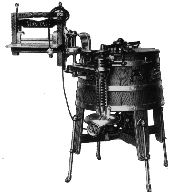 |
| French 1/2 quart self sealing jar |
 |
| Can Opener late mid 1700's |
My mother tells a story about having to go with my grandmother (her mother) to the old gym at Hogansville High School for Canning Day. This is when all the women would bring their can goods and help with canning. I watched my grandmother at a very young age do canning in her own kitchen. She had so many canned goods that anyone in the Walking Dead would be happy to find. When she died I believe we removed close to 150 Mason and Ball jars of canned goods which the contents was grown on her own land and canned for herself, family, and friends. Home canning is becoming a lost art. But a few hipsters are trying to preserve this art today.
 |
| 1700's can |
Canning using metal cans made of tin and lead, found themselves used on a full scale during the American War for Independence. Glass jars were not ideal for war because they easily broke. Someone suggested using metal to make a can and then seal the can with lead. Lead could easily be opened in the field because of its malleability. The problem is that soldiers often didn't have a way to open these tin-lead cans. They figured out if the shot at the cans, they would open. This worked most of the time, but it also caused minor injury either to the soldier firing or the solider near by. In some cases, it was reported that the cans exploded while being shot. Soldiers also thought if they played the can near the fire, that it would open the can. It did but with an explosion. After the War of Independence the use of metal cans fell into obscurity and it wasn't until the Industrial Revolution that canning began to be used on a mass scale.
During both the European and American Industrial revolution, canning saw a comeback. The cans were still made of tin, the seal made of lead but they were usually opened using a can opener. This was an easy problem to solve but there were other public safety issues. When canning became more commercial, and production rose and with most food items being about to be canned coupled with no regulation of canning the issues of, leaky lead seals which caused deceases, making people sick, let alone gave people lead poisoning was a growing concern. It wasn't unheard of to find severed body parts such as fingers and also find bugs or first stage development of infestations in canned meat. Trichinosis and other parasites were common to be found in the canning industry. By the late 1800’s most of these public safety issues has virtually gone away. It wasn't until Teddy Roosevelt that regulation of meat packing plants, and other food stuff industries that relieved diseased canned goods.
 |
| late 1800's early 1900's canned goods |
Beginning in the later 1800’s and early 1900’s the local general store began carrying commercially canned goods trying to bring the family into modern times. Women found boxed grits and crackers. They began to see canned meats and vegetables, as well as cake mixes, jams, and jellies. Most of these products were home industries. But even then, preserving food has been a forerunner of the human race, finding ways to preserve food for their families. in the late 1920’s and well through the 1930’s America, canning again was a main industry in the home. Families bartered for goods that could canned and stored. Most of the depression era families continued to can and passed the tradition on to baby boomers (like my mother). But it kind of stopped there. Dented cans could not be used due to the fact the contents would more than likely be contaminated with illness. Cans today are made of aluminum. There is no threat of disease unless something when horribly wrong. Today one can by dented cans and still live to tell about it.
 |
| Can Opener |
Today, the modern bohemian/hippie, “The Hipster”, have began to can everything. It just part of the renaissance of lost art. Canning is a art which takes patience, and a knowledge of how to can. I have friends who can and do a wonderful job with it. I am glad they have time to invest in such a venture.













